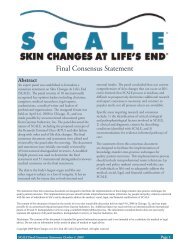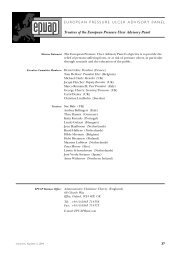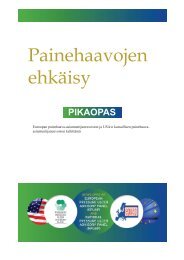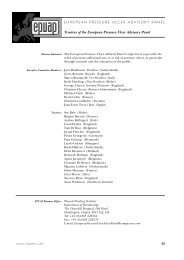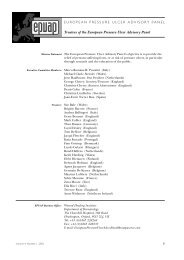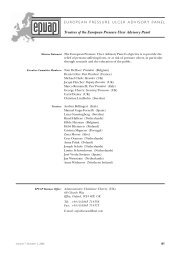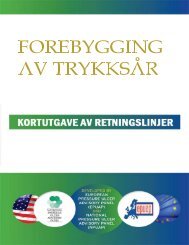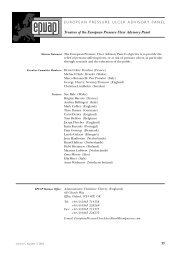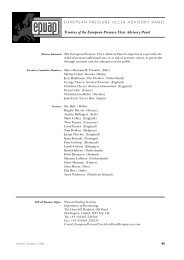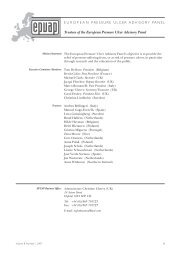EPUAP Review 10.1.indd - European Pressure Ulcer Advisory Panel
EPUAP Review 10.1.indd - European Pressure Ulcer Advisory Panel
EPUAP Review 10.1.indd - European Pressure Ulcer Advisory Panel
Create successful ePaper yourself
Turn your PDF publications into a flip-book with our unique Google optimized e-Paper software.
EUROPEAN PRESSURE ULCER ADVISORY PANEL<br />
<strong>EPUAP</strong> guidelines have been translated in many languages and have formed<br />
the basis for many national guidelines all over Europe. Up to the present<br />
day requests for guidelines reach the business office every week. Recently<br />
<strong>EPUAP</strong> joined efforts with the North American <strong>Pressure</strong> <strong>Ulcer</strong> <strong>Advisory</strong><br />
<strong>Panel</strong> (NPUAP) to develop new evidence based prevention and treatment<br />
guidelines. The final presentation of these guidelines will be done at the<br />
12th annual meeting in Amsterdam. Activities in the field of education were<br />
many in publications, but also in our annual conference, which forms a<br />
medium for profiling of <strong>EPUAP</strong>, for education of health care professionals,<br />
for networking, for dissemination of research and for contact with industry.<br />
Several working groups have assessed themes like pressure measurements,<br />
nutrition, moisture lesions, usually resulting in valuable publications.<br />
How we will progress in the near future will become clear when the trustees<br />
have agreed upon the future strategy, but I would like to highlight two<br />
points.<br />
It is clear that the development of the new <strong>EPUAP</strong>/NPUAP prevention and<br />
treatment guidelines is not an end point. There is still a huge amount of work<br />
to be done, because we have to facilitate implementation of the guidelines in<br />
the different countries of Europe, each with their own vagueness within their<br />
health care system. We are committed to translate a short version as quickly<br />
as possible in the relevant languages in Europe and we will stimulate that all<br />
necessary information about the guidelines will be available for everyone who<br />
needs it. We will also continue to educate health care professionals, patients<br />
and their relatives.<br />
Next to this I have a personal goal. Looking into the scientific literature<br />
you will notice that in the last 30 to 40 years several groups started with pressure<br />
ulcer research with one or two MSc/PhD-students and then stopped,<br />
even though what they did was worthwhile and of high quality. One of the<br />
reasons is the difficulty to get structural funding for this type of research. In<br />
Europe and many national funding agencies there is a trend to either supply<br />
personal grants to a privileged few researchers or distribute the funds via very<br />
large programs where millions of Euros are spent, but where the research<br />
has to fit within a theme. If your theme is not on the political agenda you<br />
do not have a chance of getting that funding. There are a few ways of getting<br />
around this problem, i.e. bending your research in such a way that it<br />
fits within the framework of some of the relevant themes (difficult) or put<br />
effort in putting your theme on the political agenda (even more difficult).<br />
I think that an organization like <strong>EPUAP</strong> should play a role in that, probably<br />
in cooperation with other similar societies. Researchers should also be keen<br />
on the possible application of modern technologies like nanotechnology,<br />
genomics or molecular imaging to pressure ulcers.<br />
Until that time there is another thing we can do and that is to identify<br />
groups in Europe and worldwide that perform high quality research on similar<br />
themes and to start cooperating and use each others complementarities and<br />
expertise. We have started to do this with colleagues in both Europe, Canada<br />
and Australia. In the end this will supply critical mass for these groups and<br />
possibly the means to get large scale funding. For this our annual meeting is<br />
a very important tool. We must attract scientists with a common interest in<br />
pressure ulcers, without losing the educational, clinical ‘feel’ of the meeting.<br />
In that case scientists can meet each other, but also the bridge with health<br />
care professionals and industry can be crossed. All trustees in Birmingham<br />
agreed that this mixed character of our meeting makes it a unique event.<br />
So I would like to end, by inviting you all to come to our beautiful city of<br />
Amsterdam next September for fun, education and science.<br />
Cees Oomens<br />
May 2009<br />
16<br />
Volume 10, Number 1, 2009



